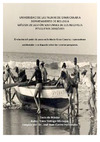Identificador persistente para citar o vincular este elemento:
https://accedacris.ulpgc.es/jspui/handle/10553/8327
| Campo DC | Valor | idioma |
|---|---|---|
| dc.contributor.advisor | Castro, J.J. | - |
| dc.contributor.author | Sistiaga Mintegui, Yayza | - |
| dc.date.accessioned | 2012-09-20T04:00:07Z | - |
| dc.date.accessioned | 2018-05-15T10:56:45Z | - |
| dc.date.available | 2012-09-20T04:00:07Z | - |
| dc.date.available | 2018-05-15T10:56:45Z | - |
| dc.date.issued | 2011 | en_US |
| dc.identifier.uri | https://accedacris.ulpgc.es/handle/10553/8327 | - |
| dc.description | Máster en Gestión Sostenible de los Recursos Pesqueros | en_US |
| dc.description.abstract | The development experienced by the artisanal fishery, taking place at the Gran Canarian waters is being analyzed through the technological improvements introduced in the fishing gear and vessels, throughout the past decades. This analysis revealed significant changes with regard to the pelagic fisher of seines, as a result of the introduction of nets of bigger size constructed with synthetic materials (in the 70s they were still made from cotton) and of instruments considerably increasing the fishing capacity of the boats (winchs, grinder, fishfinders, sonar, etc.), on top of an increase in the power of the engines and in the length of the boats. On the other hand, fishing traps has experienced less changes, in terms of the fishing methods, but the increase in power of the boats (going from rawing to onboard engines, ultrasound incorporation, etc) and the introduction of winch that facilitate the knitting of the pots, has multiplied the fishing power of the boats and has consequently, the effort performed (going from taking 10-15 fishing pots per fishing day in the 80s to 40-50 nowadays).Also the size of the fishery has increased with the increase in the engine power. Besides, recently the use of shrimp traps and of electrical reel that enable the access to other resources in deeper waters has been introduced. This increase in the fishing power has been followed by a considerable improvement in the port infrastructures (abrigos, pantalanes, almacenes, refrigeration systems, or congelado de la captura, etc.) and by the development of techniques allowing the increase of the capturability of the benthic-demersal species (development of artificial reef with scrap on behalf of the fishermen themselves). | en_US |
| dc.format | application/pdf | es |
| dc.language | spa | en_US |
| dc.rights | by-nc-nd | es |
| dc.subject | 510208 Pesca | en_US |
| dc.subject.other | artisanal fishery | en_US |
| dc.subject.other | fleet | en_US |
| dc.subject.other | fishing power | en_US |
| dc.title | Evolución del poder de pesca en la isla de Gran Canaria: repercusiones ambientales y su impacto sobre los recursos pesqueros | en_US |
| dc.type | info:eu-repo/semantics/masterThesis | en_US |
| dc.type | MasterThesis | en_US |
| dc.compliance.driver | 1 | es |
| dc.contributor.departamento | Biología | en_US |
| dc.contributor.facultad | Facultad de Ciencias del Mar | en_US |
| dc.identifier.absysnet | 667826 | es |
| dc.identifier.crisid | - | - |
| dc.investigacion | Ciencias | en_US |
| dc.rights.accessrights | info:eu-repo/semantics/openAccess | es |
| dc.type2 | Trabajo final de máster | en_US |
| dc.description.notas | Máster en Gestión Sostenible de Recursos Pesqueros | en_US |
| dc.utils.revision | Sí | en_US |
| dc.identifier.ulpgc | Sí | en_US |
| dc.contributor.buulpgc | BU-BAS | en_US |
| item.fulltext | Con texto completo | - |
| item.grantfulltext | open | - |
| crisitem.advisor.dept | GIR ECOAQUA: Biodiversidad y Conservación | - |
| crisitem.advisor.dept | IU de Investigación en Acuicultura Sostenible y Ec | - |
| crisitem.advisor.dept | Departamento de Biología | - |
| Colección: | Trabajo final de máster | |
Visitas
260
actualizado el 18-may-2024
Descargas
718
actualizado el 18-may-2024
Google ScholarTM
Verifica
Comparte
Exporta metadatos
Los elementos en ULPGC accedaCRIS están protegidos por derechos de autor con todos los derechos reservados, a menos que se indique lo contrario.
